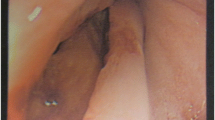Summary.
We present four cases of esophageal rupture (three iatrogenic, one Boerhaave syndrome) to demonstrate the difficulty in diagnosis and therapy. The current literature is discussed and conclusions are drawn as regards the modus operandi. All our patients were operated on. The site of esophageal rupture was always closed with a primary suture and substantial irrigation and drainage were performed. In two cases the suture line was in addition covered with fibrin glue or by an omentum flap, respectively. All patients survived and recovered was unremarkable. Our own results and a subsequent analysis of literature allow the following conclusions. At an early stage of esophageal rupture surgical intervention is indicated. The method of choice is primary closure of the rupture site by suture, possibly combined with a muscle or omentum flap. In cases of delayed diagnosis with advanced mediastinitis, suture of the rupture site should also be striven for. Additional coverage is advisable in these cases. Resection procedures with or without reconstruction should be done only in exceptional cases before of the high surgical risk.
Zusammenfassung.
Anhand von 4 eigenen Fällen einer Oesophagusperforation (3 iatrogen bedingte Perforationen, ein Boerhaave-Syndrom) werden die Problematik von Diagnostik und Therapie vor dem Hintergrund der aktuellen Literatur diskutiert und Schlußfolgerungen für die Verfahrenswahl getroffen. Wir haben in allen unseren Fällen die Indikation zur Operation gestellt. Es wurde jeweils die Perforationsstelle primär übernäht und sowie ausgiebig gespült und drainiert. In 2 Fällen wurde die Nahtstelle zusätzlich durch Fibrinklebung bzw. mit einer Omentumplastik gesichert. Alle Patienten überlebten und erholten sich ohne unmittelbare Folgen. Aufgrund dieser eigenen Ergebnisse und nach Auswertung der aktuellen Literatur scheinen uns folgende Schlußfolgerungen gerechtfertigt: Bei Sicherung einer Perforation im Frühstadium ist ein definitives chirurgisches Vorgehen indiziert. Therapieverfahren der Wahl ist der primäre Nahtverschluß, gegebenenfalls kombiniert mit einer plastischen Deckung. Auch bei verzögerter Diagnosestellung mit fortgeschrittener Mediastinitis sollte ein Nahtverschluß der Perforationsstelle versucht werden. Eine zusätzliche Sicherung ist in diesen Fällen empfehlenswert. Resezierende Verfahren mit oder ohne gleichzeitige Rekonstruktion sollten aufgrund des hohen Operationsrisikos wenigen Ausnahmefällen vorbehalten bleiben.
Similar content being viewed by others
Author information
Authors and Affiliations
Rights and permissions
About this article
Cite this article
Mai, C., Nagel, M. & Saeger, H. Die chirurgische Therapie der Oesophagusperforation Eine Standortbestimmung anhand von 4 eigenen Fällen und der Literatur. Chirurg 68, 389–394 (1997). https://doi.org/10.1007/s001040050203
Issue Date:
DOI: https://doi.org/10.1007/s001040050203




